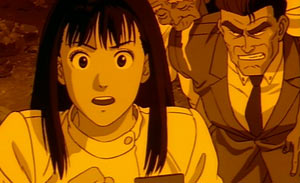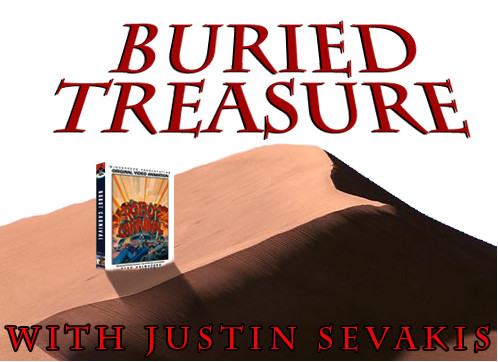Buried Treasure
Roujin Z
by Justin Sevakis,
There are plenty of anime that take their roots in social satire, but those that do seldom are up-front with their intents. Anime is, inherently, an abstract method of storytelling, and therefore their otherworldliness prohibits them from commenting directly on social issues. For every Welcome to the NHK there are several shows -- like Fullmetal Alchemist or even Blackjack -- that make their statements about society obliquely, under the guise of fantasy.
Katsuhiro Ōtomo has never shied away from social commentary in his work (or outright parody, for that matter), but usually this is in the form of allegory. Few can relate directly to Nobuo, the pharmaceutical salaryman the world military tries to destroy before he inadvertently kills the entire country with body odor in the Stink Bomb segment of Memories, but the message about the weak little guy being the death of society doesn't require a literature major to decode.
That said, there is one example of an Otomo work that stands out above the others, not only in its biting remarks about modern Japan, but in how literal its commentary is.
 Haruko is a student nurse -- a fairly average one at that. In her care is a bed-ridden elderly patent named Mr. Takazawa. Mr. Takazawa is so old that he barely makes sense, wets the bed and serves slightly less useful purpose in society than your average houseplant. As such, his family really has nothing to do with him. When a government program offers to take him off their hands so that they can use him as a test subject for their new project, the family happily signs over Next of Kin rights.
Haruko is a student nurse -- a fairly average one at that. In her care is a bed-ridden elderly patent named Mr. Takazawa. Mr. Takazawa is so old that he barely makes sense, wets the bed and serves slightly less useful purpose in society than your average houseplant. As such, his family really has nothing to do with him. When a government program offers to take him off their hands so that they can use him as a test subject for their new project, the family happily signs over Next of Kin rights.
This comes as quite a shock to Haruko, who's busy changing his bedding when a government ambulance whisks him away from his tiny old apartment. Rudely shoved aside, she's quite upset -- not just because her patient was taken away from her, but because she just can't shake the feeling that he's not being properly cared for.
 This question is soon answered in a most unexpected way at a press conference at her medical school auditorium. There, the government officials proudly unveil Project Z-101: an epoch-making elderly care hospital bed. High-tech and able to care for Mr. Takazawa's every requirement, from exercise to waste disposal, the bed seems just about perfect. The press is delighted. And then Haruko stands up: “What about love? I don't feel anything like love coming from this machine!”
This question is soon answered in a most unexpected way at a press conference at her medical school auditorium. There, the government officials proudly unveil Project Z-101: an epoch-making elderly care hospital bed. High-tech and able to care for Mr. Takazawa's every requirement, from exercise to waste disposal, the bed seems just about perfect. The press is delighted. And then Haruko stands up: “What about love? I don't feel anything like love coming from this machine!”
But the machine does love Mr. Takazawa. In fact, it bonds with him so deeply (having figured out how to impersonate his late wife) that it's soon conveying his mental wish for Haruko to help him break out of the government facility over the internet to Haruko's computer. Coming to his aid, Haruko and her (shallow) friends find themselves at odds against the government. What they didn't count on was the help of the bed itself.
 You see, the Z-101 is actually a top-secret military weapon. The whole thing about it being a hospital bed is just a cover for the fact that it's a high-powered killing machine. It's also capable of learning, of taking over other computers and even physical material, and of self-evolving. And what does this super-powered piece of lethal machinery want to do? It wants to take Mr. Takazawa to the beach. Hijinks ensue. Without giving anything away, Mr. Takazawa's beach escort ends up looking much like a classic Otomo moving-pile-of-disaster-with-military-resistance, as will be familiar to fans of Akira.
You see, the Z-101 is actually a top-secret military weapon. The whole thing about it being a hospital bed is just a cover for the fact that it's a high-powered killing machine. It's also capable of learning, of taking over other computers and even physical material, and of self-evolving. And what does this super-powered piece of lethal machinery want to do? It wants to take Mr. Takazawa to the beach. Hijinks ensue. Without giving anything away, Mr. Takazawa's beach escort ends up looking much like a classic Otomo moving-pile-of-disaster-with-military-resistance, as will be familiar to fans of Akira.
The internet was only a fragile idea at that point, before the term “information superhighway” even entered the public's consciousness. Being a work of science fiction, it's no wonder that a few aspects of the story are a bit dated. The way computers work in the film -- from various network terminals to the Z-101 itself, just don't jive with the advancements in personal computing over the last 17 years. But never mind that. What's so much fun is the story's pacing, its sense of the zany and insane. Director Hiroyuki Kitakubo (Blood: The Last Vampire, Golden Boy) uses his amazing sense of light slapstick comedy to tremendous effect, with the tongue-in-cheek tone complimenting Otomo's sense of absurdity perfectly. Some design work was also handled by Satoshi Kon, and it's interesting to draw visual parallels between the "parades of crap" in both Roujin Z and in his latest film Paprika.
 Roujin Z was dubbed into English in London back in 1995 by Manga Entertainment UK, and given a small theatrical release both there and in the United States by Central Park Media. Despite a warm critical reception (the fact that it was a Siskel & Ebert Video Pick of the Week adorned every video package I've ever seen) the film never really achieved the sort of audience one would expect of a film of this stature.
Roujin Z was dubbed into English in London back in 1995 by Manga Entertainment UK, and given a small theatrical release both there and in the United States by Central Park Media. Despite a warm critical reception (the fact that it was a Siskel & Ebert Video Pick of the Week adorned every video package I've ever seen) the film never really achieved the sort of audience one would expect of a film of this stature.
The English dub was, like nearly all Manga UK dubs, directed by Michael Bakewell, and it's one of the ones that plays quite fast and loose with the translation. While purists may sniff at the fairly large liberties taken, it was actually quite a thoughtful adaptation of the original work, bringing out a harder edge to satire that Western audiences may not have even recognized as such. One of my favorite scenes involves a board room meeting with government officials, where nearly every term, demographic or agency is given an acronym – and said acronyms become increasingly silly. So little mind is paid to them that they fly by if you don't listen closely. Other great touches including the Z-101 program head boasting that the machine's entertainment selection includes reggae, heavy metal and rap.
 Haruko is played by Toni Barry, who I always felt was a bit miscast, sounding appropriately girly and big-hearted, but also a little ditzy, which Haruko certainly is not. Other roles, filled largely by Manga UK regulars, work well with the film's sense of frivolity.
I've long suspected that the film's lack of popularity could be chalked up to several things: first, how desperately unsexy it is. Despite Haruko being somewhat cute, none of the movie's character designs (by Hisashi Eguchi) are particularly attractive, and as far as anime's target demographic of teenagers and young adults go… well, it's hard to imagine a robot hospital bed being something the kids'd want to shell out their hard-earned money to see.
Haruko is played by Toni Barry, who I always felt was a bit miscast, sounding appropriately girly and big-hearted, but also a little ditzy, which Haruko certainly is not. Other roles, filled largely by Manga UK regulars, work well with the film's sense of frivolity.
I've long suspected that the film's lack of popularity could be chalked up to several things: first, how desperately unsexy it is. Despite Haruko being somewhat cute, none of the movie's character designs (by Hisashi Eguchi) are particularly attractive, and as far as anime's target demographic of teenagers and young adults go… well, it's hard to imagine a robot hospital bed being something the kids'd want to shell out their hard-earned money to see.
However, as those of us who first grew up with anime start to get older, they tend to complain that not enough anime is intelligent, that as a medium it's become bogged down in juvenile pandering and lowest-common-denominator storytelling. I don't think that's quite fair, but it's hard to argue that we could certainly use more anime like Roujin Z.
Now, get off my lawn.
| Obscure-O-Meter™ | |
| A | Abundant. Available anywhere that carries anime. |
| C | Common. In print, and always available online. |
| R1 | US release out of print, still in stock most places. |
| R2 | US release out of print, not easy to find. |
| R3 | Import only, but it has English on it. |
| R4 | Import only. Fansubs commonly available. |
| R5 | Import only, and out of print. Fansubs might be out there. |
| R6 | Import long out of print. No fansubs are known to exist. |
| R7 | Very rare. Limited import release or aired on TV with no video release. No fansubs known to exist. |
| R8 | Never been on the market. Almost impossible to obtain. |
| Adapted from Soviet-Awards.com. | |
How To Get It:
There are lots of repackages of CPM's DVD, but the disc itself is the same: a good-looking, non-anamorphic widescreen print with decent subtitles. An earlier release by Image used the English dub as its master, and unfortunately this was originated from the UK PAL master -- meaning the image is nowhere near the same quality. That version is getting hard to find nowadays, so if you find one in a standard DVD case you're probably safe. CPM's DVD is also dirt-cheap, going for less than $7 in some places.
Screenshots ©1991 Tokyo Theaters Co., Inc./The Television Inc./Movic Co., Ltd./TV Asahi/Sony Music Entertainment (Japan) Inc. All rights reserved.
discuss this in the forum (37 posts) |
